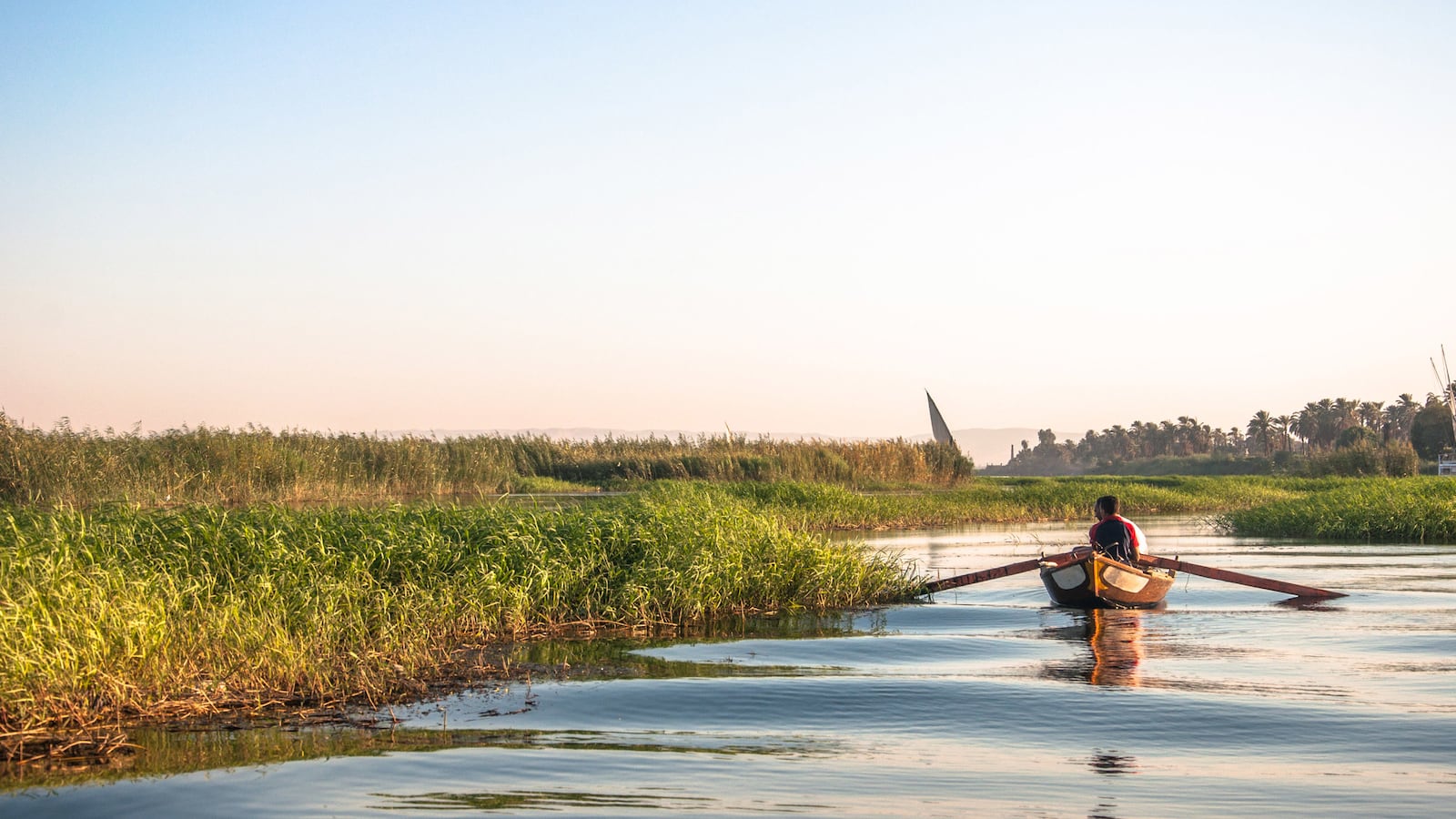Time travelers from centuries past would assuredly be shocked by planes, cars, iPhones, and Kimye on the cover of Vogue. Another detail of modern life they would likely find jarring is how little nature affects daily lives in wealthy countries.
Yes, hurricanes, earthquakes, drought, and a polar vortex affect people now and then—but their impact is measured by FEMA funding fights, dime-size super-market price increases, and lawn-watering regulations. That sense of detachment from the caprices of Mother Nature is pretty unique in human history.
That feature of modern life (which may come to a devastating end if climate change’s predicted consequences bear fruit) hangs over the first-rate The Nile: A Journey Downriver Through Egypt’s Past and Present by award-winning historian Toby Wilkinson.
There is perhaps nowhere in world history where the beneficence and cruelty of Mother Nature can be felt more directly than on the Nile. “Without the Nile,” declares Wilkinson, “there would be no Egypt.” It is one of the world’s oldest highways, transporting goods, people, and ideas thousands of miles. But fluctuations of mere feet during its flood season could sustain the rise of empires, or hasten their fall. So too, could it encourage population booms, or wipe out millions through starvation and destruction.
For thousands of years, right on through the construction of the Suez Canal, railroads, and the Aswan Dam, the Nile’s story was the story of Egypt.
For Wilkinson, the story of Egypt as it relates to the Nile begins in Aswan, and it is from Aswan that his book travels the course of Egyptian history as it winds downstream toward Cairo. As he works his way from site to site in this densely-packed book, the immense value of the book becomes clear both for the unfathomably ancient history Wilkinson unveils, as well as the beguiling descriptions of the impossible number of sights to see that have shaped history.
Wilkinson’s book is also an astoundingly (and probably unintentionally) useful travel guide. The object of desire for travelers with disposable income these days are the “unique” experiences—to go where no other tourists are and not to stand out like a sore thumb. Many of the destinations Wilkinson illustrates, particularly in Upper and Middle Egypt, could be found in the latest issue of the New York Times travel section or Condé Nast Traveler. His visit to Mostagedda, one of the oldest archaeological sites along the Nile, opens with the line “There were no buses for where I wanted to go; not even a service taxi.” The exclusivity of parts of Egypt is a bit ironic, as history has had perhaps no more popular travel destination.
He takes the reader to Nag Hammadi and Abydos, where fear of terrorist attacks keeps most tourists from seeing the burial tomb of the actual scorpion king, the site where the non-canonical gospels like the Gospel of Truth and the Secret Book of James were found, and the temple of Seti I, which he describes as “a real show-stopper. It is, without question, the most beautiful temple in a country of spectacular temples.”
You will have to forgive him for labeling more than one destination in such a superlative fashion.
The town of Elkab (Nekheb) is a fine example. Often skipped over by tourist cruises, according to Wilkinson, it contains rock-cut tombs with scenes of life from 3,500 years ago, with fragments of pottery stretching back thousands of years earlier, and stone axe-handles going back 300,000 years. Still standing across the river, at the city of Nekhen, is a 22 by 188 feet fort made of mud-brick. Built circa 2700 BC, it is the oldest freestanding mud-brick building in the world. Just a few miles away, a burial ground from 3800 BC contains the earliest evidence of sacred animals buried with their masters and the now-lost “Painted Tomb,” the oldest known decorated royal tomb.
Or, for those looking for modern conveniences without the crowd, there is Gebel el-Silsila, which despite government investments in modern infrastructure, is often overlooked. It is the site of ancient stone quarries whose “yellow cliffs,” as one writer put it, “have been sliced as neatly as the cheeses in a cheesemonger’s window.”
Wlkinson even offers tips on when to visit the sites, arguing the best time is between noon and two o’clock. “Not for the faint-hearted” he writes, but you avoid the hawkers and tour groups from the morning, and the afternoon groups have not arrived.
As Nekhen and Nekhen demonstrate, the history of Egypt is deep—a range and scope impenetrable in some ways for the modern mind. The Rome we refer to as ancient is a mere infant compared to Egypt.
The village of Qift, for instance, has been continuously occupied for 5,000 years, and has seen its fortunes rise and fall. Its history encompasses royal tax exemptions in the Old Kingdom, its central role in the civil war led by Thebes, its service as a major shipment hub under the Romans and then as a religious refuge for persecuted Christians and then Muslims, and finally its descent into obscurity after the Suez Canal dominated all shipping along the Red Sea.
The amount of human history etched into towns along the river often leads Wilkinson to refer to the Nile as a palimpsest, however it just left me wishing for a timeline on nearly every page.
What makes Wilkinson’s book most worthwhile are the details he dishes out on the various men and women who made their mark on the river.
He recounts the story of Ananiah ben Azariah and the Jewish community on Elephantine in the centuries before and after Persian conquest in 525 BC. The common occupation for the Jewish men there was as mercenaries, intermixed with gentiles, and all swore oaths to the Egyptain goddess Satet.
We learn that Winston Churchill’s bellicosity began at a young age, as he argued while a teenager that the famous Temple of Isis at Philae should be drowned in order to gain the economic benefits of the Aswan Dam. In contrast, Wilkinson digs up a quote from an unnamed European traveler who declares, “There are four recollections of a traveler, which might tempt him to wish to live for ever: the sea view of Constantinople, the sight of the Coliseum by moonlight, the prospect from the summit of Vesuvius at the dawn, and the first glimpse of Philae at sunset.”
Wilkinson chronicles the story of Dominique Vivant Denon, who escaped the guillotine in the French Revolution and went on to publish an account of the Nile that intoxicated the French public. One of those affected men, Jean-Francois Champollion, took up the task of negotiating with the Viceroy of Egypt, Muhammad Ali, for an obelisk for France—specifically, one of Luxor obelisks. After years of negotiations and a tough journey, the obelisk was planted at the Place de la Concorde. The best part of the story, however, may be when the British writer and Egyptophile Amelia Edwards sneers that she imagines the splendid work looking “with melancholy indifference upon the petty revolutions and counter-revolutions of the Place de la Concorde.”
In movies, the character seen frequently in Egypt is that of the archaeologist, and Wilkinson uncovers some memorable ones. The first, William Matthew Flinders Petrie, who is called “the father of Egyptian archaeology,” was famous not only for developing a detailed and exhaustive system for digs but also for his miserly attitude. His method “verged on asceticism,” writes Wilkinson, and while aspiring archaeologists would do best to learn on his camps, they were “regarded with dread.” Petrie’s penny-pinching ways so shocked a priest that it drove him to record in detail the conditions at his camp. Petrie’s wife was tough as well—in Qift she had a run-in with the bane of archaeologists—the bandit. One bandit came in the night to rob the couple, and shot at his wife when she exited the house. “Happily,” recorded Petrie, “she escaped.”
There are also the looting and desecrating “archaeologists” for whom Wilkinson reserves his most scornful language. One was Emile Amélineau, who headed up excavations at Abydos at the turn of the century. According to Petrie, who had to rescue the site, “No plans were kept, there was no record of where things were found.” Even worse, Amélineau “boasted that he had reduced to chips the pieces of stone vases which he did not care to remove, and burnt up the remains of the woodwork of the 1st dynasty in his kitchen.” He then went on to sell or gift many of the items. As Petrie notes, and one can be forgiven for nodding in agreement, “It was the usual French work, but with total indifference to what became of things.”
The second monster was an Englishman, Richard Vyse, who on a visit to Egypt in 1835 became fascinated by the pyramids of Giza. To satisfy that particular itch, he came back the next year and drilled a hole into the Sphinx to find hidden passages (none there), blasted holes in chambers in the Great Pyramid, and “caused irreparable damage to nearly every pyramid at Giza.”
The only glaring weakness in the text is Wilkinson’s fondness for halcyon days of yore at the expense of the present. His relationships with Egyptians and Westerners of the past are far more engaging and intimate than his disdain for contemporary tourists and trinket-hawkers encountered along his way.
It is unlikely, however, that will be the reason Egypt lovers or those dreaming of someday seeing its wonders will pick up the book. Instead, it will be because the Nile and the history it has engendered still manage to stir something in all of us.






